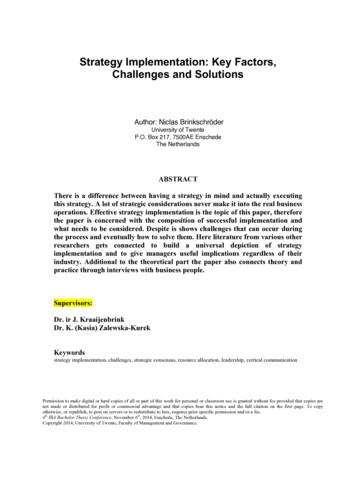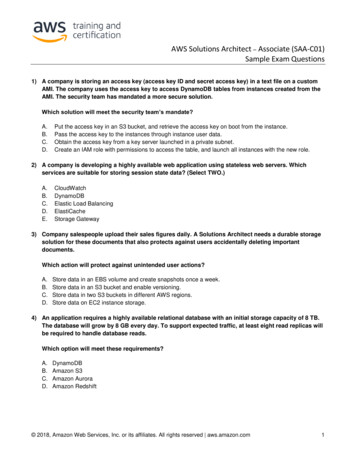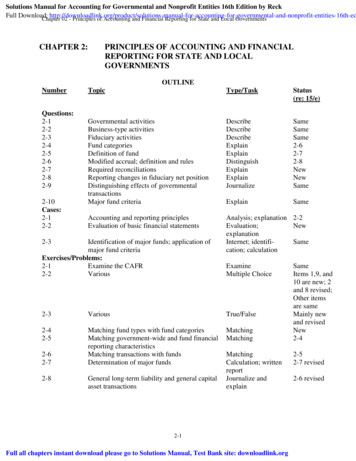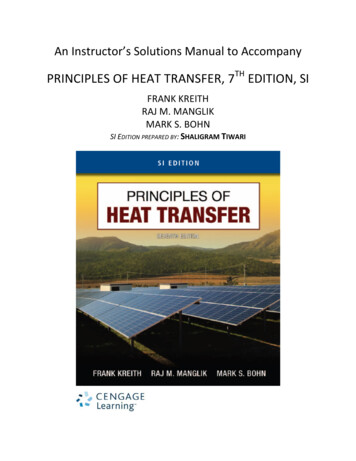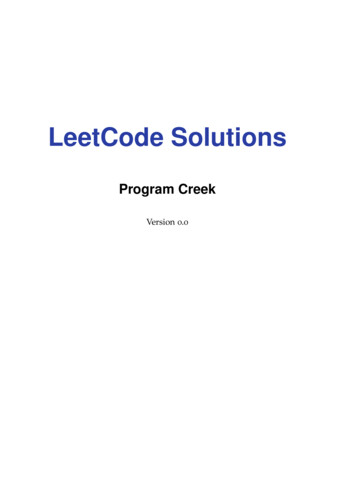
Transcription
LeetCode SolutionsProgram CreekVersion 0.0
Contents1Rotate Array in Java72Evaluate Reverse Polish Notation93Solution of Longest Palindromic Substring in Java114Solution Word Break155Word Break II186Word Ladder207Median of Two Sorted Arrays Java238Regular Expression Matching in Java259Merge Intervals2710 Insert Interval2911 Two Sum3112 Two Sum II Input array is sorted3213 Two Sum III Data structure design3314 3Sum3415 4Sum3616 3Sum Closest3817 String to Integer (atoi)3918 Merge Sorted Array4019 Valid Parentheses4220 Implement strStr()432 181
Contents21 Set Matrix Zeroes4422 Search Insert Position4623 Longest Consecutive Sequence Java4724 Valid Palindrome4925 Spiral Matrix5226 Search a 2D Matrix5527 Rotate Image5628 Triangle5829 Distinct Subsequences Total6030 Maximum Subarray6231 Maximum Product Subarray6332 Remove Duplicates from Sorted Array6433 Remove Duplicates from Sorted Array II6734 Longest Substring Without Repeating Characters6935 Longest Substring Which Contains 2 Unique Characters7136 Palindrome Partitioning7337 Reverse Words in a String7538 Find Minimum in Rotated Sorted Array7639 Find Minimum in Rotated Sorted Array II7740 Find Peak Element7841 Min Stack7942 Majority Element8043 Combination Sum8244 Best Time to Buy and Sell Stock8345 Best Time to Buy and Sell Stock II84Program Creek3 181
Contents46 Best Time to Buy and Sell Stock III8547 Best Time to Buy and Sell Stock IV8648 Longest Common Prefix8849 Largest Number8950 Combinations9051 Compare Version Numbers9252 Gas Station9353 Candy9554 Jump Game9655 Pascal’s Triangle9756 Container With Most Water9857 Count and Say9958 Repeated DNA Sequences10059 Add Two Numbers10160 Reorder List10561 Linked List Cycle10962 Copy List with Random Pointer11163 Merge Two Sorted Lists11464 Merge k Sorted Lists11665 Remove Duplicates from Sorted List11766 Partition List11967 LRU Cache12168 Intersection of Two Linked Lists12469 Java PriorityQueue Class Example12570 Solution for Binary Tree Preorder Traversal in Java1274 181Program Creek
Contents71 Solution of Binary Tree Inorder Traversal in Java12872 Solution of Iterative Binary Tree Postorder Traversal in Java13073 Validate Binary Search Tree13174 Flatten Binary Tree to Linked List13375 Path Sum13476 Construct Binary Tree from Inorder and Postorder Traversal13677 Convert Sorted Array to Binary Search Tree13778 Convert Sorted List to Binary Search Tree13879 Minimum Depth of Binary Tree14080 Binary Tree Maximum Path Sum14281 Balanced Binary Tree14382 Symmetric Tree14583 Clone Graph Java14684 How Developers Sort in Java?14985 Solution Merge Sort LinkedList in Java15186 Quicksort Array in Java15487 Solution Sort a linked list using insertion sort in Java15688 Maximum Gap15889 Iteration vs. Recursion in Java16090 Edit Distance in Java16391 Single Number16592 Single Number II16693 Twitter Codility Problem Max Binary Gap16694 Number of 1 Bits16795 Reverse Bits168Program Creek5 181
Contents96 Permutations16997 Permutations II17198 Permutation Sequence17399 Generate Parentheses175100 Reverse Integer176101 Palindrome Number178102 Pow(x, n)1796 181Program Creek
1 Rotate Array in JavaYou may have been using Java for a while. Do you think a simple Java array questioncan be a challenge? Let’s use the following problem to test.Problem: Rotate an array of n elements to the right by k steps. For example, with n 7 and k 3, the array [1,2,3,4,5,6,7] is rotated to [5,6,7,1,2,3,4].How many different ways do you know to solve this problem?1.1 Solution 1 - Intermediate ArrayIn a straightforward way, we can create a new array and then copy elements to thenew array. Then change the original array by using System.arraycopy().public void rotate(int[] nums, int k) {if(k nums.length)k k%nums.length;int[] result new int[nums.length];for(int i 0; i k; i ){result[i] nums[nums.length-k i];}int j 0;for(int i k; i nums.length; i ){result[i] nums[j];j ;}System.arraycopy( result, 0, nums, 0, nums.length );}Space is O(n) and time is O(n).1.2 Solution 2 - Bubble RotateCan we do this in O(1) space?This solution is like a bubble sort.public static void rotate(int[] arr, int order) {if (arr null order 0) {throw new IllegalArgumentException("Illegal argument!");7 181
1 Rotate Array in Java}for (int i 0; i order; i ) {for (int j arr.length - 1; j 0; j--) {int temp arr[j];arr[j] arr[j - 1];arr[j - 1] temp;}}}However, the time is O(n*k).1.3 Solution 3 - ReversalCan we do this in O(1) space and in O(n) time? The following solution does.Assuming we are given 1,2,3,4,5,6 and order 2. The basic idea is:1.2.3.4.DivideRotateRotateRotatethe array two parts: 1,2,3,4 and 5, 6first part: 4,3,2,1,5,6second part: 4,3,2,1,6,5the whole array: 5,6,1,2,3,4public static void rotate(int[] arr, int order) {order order % arr.length;if (arr null order 0) {throw new IllegalArgumentException("Illegal argument!");}//length of first partint a arr.length - order;reverse(arr, 0, a-1);reverse(arr, a, arr.length-1);reverse(arr, 0, arr.length-1);}public static void reverse(int[] arr, int left, int right){if(arr null arr.length 1)return;while(left right){int temp arr[left];arr[left] arr[right];arr[right] temp;left ;right--;8 181Program Creek
}}2 Evaluate Reverse Polish NotationThe problem:Evaluate the value of an arithmetic expression in Reverse Polish Notation.Valid operators are , -, *, /. Each operand may be an integer or anotherexpression.Some examples:["2", "1", " ", "3", "*"] - ((2 1) * 3) - 9["4", "13", "5", "/", " "] - (4 (13 / 5)) - 62.1 Naive ApproachThis problem is simple. After understanding the problem, we should quickly realizethat this problem can be solved by using a stack. We can loop through each elementin the given array. When it is a number, push it to the stack. When it is an operator,pop two numbers from the stack, do the calculation, and push back the result.The following is the code. It runs great by feeding a small test. However, this code9 181
2 Evaluate Reverse Polish Notationcontains compilation errors in leetcode. Why?public class Test {public static void main(String[] args) throws IOException {String[] tokens new String[] { "2", "1", " ", "3", "*" };System.out.println(evalRPN(tokens));}public static int evalRPN(String[] tokens) {int returnValue 0;String operators " -*/";Stack String stack new Stack String ();for (String t : tokens) {if (!operators.contains(t)) {stack.push(t);} else {int a Integer.valueOf(stack.pop());int b Integer.valueOf(stack.pop());switch (t) {case " ":stack.push(String.valueOf(a b));break;case "-":stack.push(String.valueOf(b - a));break;case "*":stack.push(String.valueOf(a * b));break;case "/":stack.push(String.valueOf(b / a));break;}}}returnValue Integer.valueOf(stack.pop());return returnValue;}}The problem is that switch string statement is only available from JDK 1.7. Leetcodeapparently use versions below that.10 181Program Creek
2.2 Accepted SolutionIf you want to use switch statement, you can convert the above by using the followingcode which use the index of a string " -*/".public class Solution {public int evalRPN(String[] tokens) {int returnValue 0;String operators " -*/";Stack String stack new Stack String ();for(String t : else{int a Integer.valueOf(stack.pop());int b Integer.valueOf(stack.pop());int index operators.indexOf(t);switch(index){case 0:stack.push(String.valueOf(a b));break;case 1:stack.push(String.valueOf(b-a));break;case 2:stack.push(String.valueOf(a*b));break;case alue Integer.valueOf(stack.pop());return returnValue;}}11 181
3 Solution of Longest Palindromic Substring in Java3 Solution of Longest PalindromicSubstring in JavaFinding the longest palindromic substring is a classic problem of coding interview. Inthis post, I will summarize 3 different solutions for this problem.3.1 Naive ApproachNaively, we can simply examine every substring and check if it is palindromic. Thetime complexity is O(n3̂). If this is submitted to LeetCode onlinejudge, an error message will be returned - "Time Limit Exceeded". Therefore, this approach is just a start,we need a better algorithm.public static String longestPalindrome1(String s) {int maxPalinLength 0;String longestPalindrome null;int length s.length();// check all possible sub stringsfor (int i 0; i length; i ) {for (int j i 1; j length; j ) {int len j - i;String curr s.substring(i, j 1);if (isPalindrome(curr)) {if (len maxPalinLength) {longestPalindrome curr;maxPalinLength len;}}}}return longestPalindrome;}public static boolean isPalindrome(String s) {for (int i 0; i s.length() - 1; i ) {if (s.charAt(i) ! s.charAt(s.length() - 1 - i)) {return false;}}return true;}12 181Program Creek
3 Solution of Longest Palindromic Substring in Java3.2 Dynamic ProgrammingLet s be the input string, i and j are two indices of the string.Define a 2-dimension array "table" and let table[i][j] denote whether substring fromi to j is palindrome.Start condition:table[i][i] 1;table[i][i 1] 1 s.charAt(i) s.charAt(i 1)Changing condition:table[i 1][j-1] 1 && s.charAt(i) s.charAt(j) table[i][j] 1Time O(n2̂) Space O(n2̂)public static String longestPalindrome2(String s) {if (s null)return null;if(s.length() 1)return s;int maxLen 0;String longestStr null;int length s.length();int[][] table new int[length][length];//every single letter is palindromefor (int i 0; i length; i ) {table[i][i] 1;}printTable(table);//e.g. bcba//two consecutive same letters are palindromefor (int i 0; i length - 2; i ) {if (s.charAt(i) s.charAt(i 1)){table[i][i 1] 1;longestStr s.substring(i, i 2);}}printTable(table);//condition for calculate whole tablefor (int l 3; l length; l ) {for (int i 0; i length-l; i ) {Program Creek13 181
3 Solution of Longest Palindromic Substring in Javaint j i l - 1;if (s.charAt(i) s.charAt(j)) {table[i][j] table[i 1][j - 1];if (table[i][j] 1 && l maxLen)longestStr s.substring(i, j 1);} else {table[i][j] 0;}printTable(table);}}return longestStr;}public static void printTable(int[][] x){for(int [] y : x){for(int z: y){System.out.print(z " --");}Given an input, we can use printTable method to examine the table after each iteration. For example, if input string is "dabcba", the final matrix would be the following:100000010000001000000100001010010001From the table, we can clear see that the longest string is in cell table[1][5].3.3 Simple AlgorithmFrom Yifan’s comment below.Time O(n2̂), Space O(1)public String longestPalindrome(String s) {if (s.isEmpty()) {return null;}if (s.length() 1) {return s;}14 181Program Creek
String longest s.substring(0, 1);for (int i 0; i s.length(); i ) {// get longest palindrome with center of iString tmp helper(s, i, i);if (tmp.length() longest.length()) {longest tmp;}// get longest palindrome with center of i, i 1tmp helper(s, i, i 1);if (tmp.length() longest.length()) {longest tmp;}}return longest;}// Given a center, either one letter or two letter,// Find longest palindromepublic String helper(String s, int begin, int end) {while (begin 0 && end s.length() - 1 && s.charAt(begin) s.charAt(end)) {begin--;end ;}return s.substring(begin 1, end);}3.4 Manacher’s AlgorithmManacher’s algorithm is much more complicated to figure out, even though it willbring benefit of time complexity of O(n).Since it is not typical, there is no need to waste time on that.4 Solution Word BreakGiven a string s and a dictionary of words dict, determine if s can be segmented intoa space-separated sequence of one or more dictionary words. For example, given s "leetcode", dict ["leet", "code"]. Return true because "leetcode" can be segmented as"leet code".15 181
4 Solution Word Break4.1 Naive ApproachThis problem can be solve by using a naive approach, which is trivial. A discussioncan always start from that though.public class Solution {public boolean wordBreak(String s, Set String dict) {return wordBreakHelper(s, dict, 0);}public boolean wordBreakHelper(String s, Set String dict, int start){if(start s.length())return true;for(String a: dict){int len a.length();int end start len;//end index should be string lengthif(end s.length())continue;if(s.substring(start, start len).equals(a))if(wordBreakHelper(s, dict, start len))return true;}return false;}}Time: O(n2̂)This solution exceeds the time limit.4.2 Dynamic ProgrammingThe key to solve this problem by using dynamic programming approach: Define an array t[] such that t[i] true 0-(i-1) can be segmented using dictionary Initial state t[0] truepublic class Solution {public boolean wordBreak(String s, Set String dict) {boolean[] t new boolean[s.length() 1];t[0] true; //set first to be true, why?//Because we need initial statefor(int i 0; i s.length(); i ){16 181Program Creek
4 Solution Word Break//should continue from match positionif(!t[i])continue;for(String a: dict){int len a.length();int end i len;if(end s.length())continue;if(t[end]) continue;if(s.substring(i, end).equals(a)){t[end] true;}}}return t[s.length()];}}Time: O(string length * dict size)One tricky part of this solution is the case:INPUT: "programcreek", ["programcree","program","creek"].We should get all possible matches, not stop at "programcree".4.3 Regular ExpressionThe problem is supposed to be equivalent to matching the regexp (leet code)*, whichmeans that it can be solved by building a DFA in O(2m̂) and executing it in O(n).(Thanks to hdante.) Leetcode online judge does not allow using Pattern class though.public static void main(String[] args) {HashSet String dict new HashSet String ");dict.add("special");StringBuilder sb new StringBuilder();for(String s: dict){sb.append(s " ");}String pattern sb.toString().substring(0, sb.length()-1);Program Creek17 181
pattern "(" pattern ")*";Pattern p Pattern.compile(pattern);Matcher m t.println("match");}}4.4 The More Interesting ProblemThe dynamic solution can tell us whether the string can be broken to words, but cannot tell us what words the string is broken to. So how to get those words?Check out Word Break II.5 Word Break IIGiven a string s and a dictionary of words dict, add spaces in s to construct a sentencewhere each word is a valid dictionary word. Return all such possible sentences.For example, given s "catsanddog", dict ["cat", "cats", "and", "sand", "dog"], thesolution is ["cats and dog", "cat sand dog"].5.1 Java Solution - Dynamic ProgrammingThis problem is very similar to Word Break. Instead of using a boolean array to trackthe match positions, we need to track the actual words. Then we can use depth firstsearch to get all the possible paths, i.e., the list of strings.The following diagram shows the structure of the tracking array.18 181
5 Word Break IIpublic static List String wordBreak(String s, Set String dict) {//create an array of ArrayList String List String dp[] new ArrayList[s.length() 1];dp[0] new ArrayList String ();for(int i 0; i s.length(); i ){if( dp[i] null )continue;for(String word:dict){int len word.length();int end i len;if(end ord)){if(dp[end] null){dp[end] new ArrayList String ();}dp[end].add(word);}}}List String result new LinkedList String ();if(dp[s.length()] null)return result;Program Creek19 181
ArrayList String temp new ArrayList String ();dfs(dp, s.length(), result, temp);return result;}public static void dfs(List String dp[],int end,List String result,ArrayList String tmp){if(end 0){String path tmp.get(tmp.size()-1);for(int i tmp.size()-2; i 0; i--){path " " tmp.get(i) ;}result.add(path);return;}for(String str : dp[end]){tmp.add(str);dfs(dp, end-str.length(), result, tmp);tmp.remove(tmp.size()-1);}}6 Word LadderThe problem:Given two words (start and end), and a dictionary, find the length of shortest transformation sequence from start to end, such that:Only one letter can be changed at a time Each intermediate word must exist in thedictionary For example,Given:start "hit"end "cog"dict ["hot","dot","dog","lot","log"]As one shortest transformation is "hit" - "hot" - "dot" - "dog" - "cog", the programshould return its length 5.Note: Return 0 if there is no such transformation sequence. All words have the samelength. All words contain only lowercase alphabetic characters.This problem is a classic problem that has been asked frequently during interviews.20 181
6 Word LadderThe following are two Java solutions.6.1 Naive ApproachIn a simplest way, we can start from start word, change one character each time, if itis in the dictionary, we continue with the replaced word, until start end.public class Solution {public int ladderLength(String start, String end, HashSet String dict) {int len 0;HashSet String visited new HashSet String ();for(int i 0; i start.length(); i ){char[] startArr start.toCharArray();for(char c ’a’; c ’z’; c ){if(c start.toCharArray()[i]){continue;}startArr[i] c;String temp new String(startArr);if(dict.contains(temp)){len ;start temp;if(temp.equals(end)){return len;}}}}return len;}}Apparently, this is not good enough. The following example exactly shows theproblem. It can not find optimal path. The output is 3, but it actually only takes 2.Input: "a", "c", ["a","b","c"]Output: 3Expected: 26.2 Breath First SearchSo we quickly realize that this looks like a tree searching problem for which breathfirst guarantees the optimal solution.Program Creek21 181
6 Word LadderAssuming we have some words in the dictionary, and the start is "hit" as shown inthe diagram below.We can use two queues to traverse the tree, one stores the nodes, the other stores thestep numbers.Updated on 2/27/2015.public int ladderLength(String start, String end, HashSet String dict) {if (dict.size() 0)return 0;dict.add(end);LinkedList String wordQueue new LinkedList String ();LinkedList Integer distanceQueue new LinkedList Integer ck the shortest pathint result Integer.MAX VALUE;while (!wordQueue.isEmpty()) {String currWord wordQueue.pop();Integer currDistance distanceQueue.pop();if (currWord.equals(end)) {result Math.min(result, currDistance);}for (int i 0; i currWord.length(); i ) {char[] currCharArr currWord.toCharArray();for (char c ’a’; c ’z’; c ) {22 181Program Creek
currCharArr[i] c;String newWord new String(currCharArr);if (dict.contains(newWord)) ance 1);dict.remove(newWord);}}}}if (result Integer.MAX VALUE)return result;elsereturn 0;}6.3 What learned from this problem? Use breath-first or depth-first search to solve problems Use two queues, one for words and another for counting7 Median of Two Sorted Arrays JavaLeetCode Problem:There are two sorted arrays A and B of size m and n respectively. Find the median of thetwo sorted arrays. The overall run time complexity should be O(log (m n)).7.1 Java SolutionThis problem can be converted to the problem of finding kth element, k is (A’s length B’ Length)/2.If any of the two arrays is empty, then the kth element is the non-empty array’s kthelement. If k 0, the kth element is the first element of A or B.For normal cases(all other cases), we need to move the pointer at the pace of half ofan array length.public static double findMedianSortedArrays(int A[], int B[]) {int m A.length;int n B.length;23 181
if ((m n) % 2 ! 0) // oddreturn (double) findKth(A, B, (m n) / 2, 0, m - 1, 0, n - 1);else { // evenreturn (findKth(A, B, (m n) / 2, 0, m - 1, 0, n - 1) findKth(A, B, (m n) / 2 - 1, 0, m - 1, 0, n - 1)) * 0.5;}}public static int findKth(int A[], int B[], int k,int aStart, int aEnd, int bStart, int bEnd) {int aLen aEnd - aStart 1;int bLen bEnd - bStart 1;// Handle special casesif (aLen 0)return B[bStart k];if (bLen 0)return A[aStart k];if (k 0)return A[aStart] B[bStart] ? A[aStart] : B[bStart];int aMid aLen * k / (aLen bLen); // a’s middle countint bMid k - aMid - 1; // b’s middle count// make aMid and bMid to be array indexaMid aMid aStart;bMid bMid bStart;if (A[aMid] B[bMid]) {k k - (bMid - bStart 1);aEnd aMid;bStart bMid 1;} else {k k - (aMid - aStart 1);bEnd bMid;aStart aMid 1;}return findKth(A, B, k, aStart, aEnd, bStart, bEnd);}7.2 The Steps of the AlgorithmThanks to Gunner86. The description of the algorithm is awesome!1) Calculate the medians m1 and m2 of the input arrays ar1[] and ar2[] respectively.2) If m1 and m2 both are equal then we are done, and return m1 (or m2) 3) If m124 181
8 Regular Expression Matching in Javais greater than m2, then median is present in one of the below two subarrays. a)From first element of ar1 to m1 (ar1[0. n/2 ]) b) From m2 to last element of ar2(ar2[ n/2 .n-1]) 4) If m2 is greater than m1, then median is present in one of thebelow two subarrays. a) From m1 to last element of ar1 (ar1[ n/2 .n-1]) b) Fromfirst element of ar2 to m2 (ar2[0. n/2 ]) 5) Repeat the above process until size ofboth the subarrays becomes 2. 6) If size of the two arrays is 2 then use below formulato get the median. Median (max(ar1[0], ar2[0]) min(ar1[1], ar2[1]))/28 Regular Expression Matching in JavaProblem:Implement regular expression matching with support for ’.’ and ’*’.’.’ Matches any single character.’*’ Matches zero or more of the preceding element.The matching should cover the entire input string (not partial).The function prototype should be:bool isMatch(const char *s, const char *p)Some examples:isMatch("aa","a") return falseisMatch("aa","aa") return trueisMatch("aaa","aa") return falseisMatch("aa", "a*") return trueisMatch("aa", ".*") return trueisMatch("ab", ".*") return trueisMatch("aab", "c*a*b") return true8.1 AnalysisFirst of all, this is one of the most difficulty problems. It is hard to handle many cases.The problem should be simplified to handle 2 basic cases: the second char of pattern is "*" the second char of pattern is not "*"For the 1st case, if the first char of pattern is not ".", the first char of pattern andstring should be the same. Then continue to match the left part.For the 2nd case, if the first char of pattern is "." or first char of pattern the first ichar of string, continue to match the left.Be careful about the offset.Program Creek25 181
8 Regular Expression Matching in Java8.2 Java Solution 1 (Short)The following Java solution is accepted.public class Solution {public boolean isMatch(String s, String p) {if(p.length() 0)return s.length() 0;//p’s length 1 is special caseif(p.length() 1 p.charAt(1) ! ’*’){if(s.length() 1 (p.charAt(0) ! ’.’ && s.charAt(0) ! p.charAt(0)))return false;return isMatch(s.substring(1), p.substring(1));}else{int len s.length();int i -1;while(i len && (i 0 p.charAt(0) ’.’ p.charAt(0) s.charAt(i))){if(isMatch(s.substring(i 1), p.substring(2)))return true;i ;}return false;}}}8.3 Java Solution 2 (More Readable)public boolean isMatch(String s, String p) {// base caseif (p.length() 0) {return s.length() 0;}// special caseif (p.length() 1) {// if the length of s is 0, return falseif (s.length() 1) {return false;}26 181Program Creek
//if the first does not match, return falseelse if ((p.charAt(0) ! s.charAt(0)) && (p.charAt(0) ! ’.’)) {return false;}// otherwise, compare the rest of the string of s and p.else {return isMatch(s.substring(1), p.substring(1));}}// case 1: when the second char of p is not ’*’if (p.charAt(1) ! ’*’) {if (s.length() 1) {return false;}if ((p.charAt(0) ! s.charAt(0)) && (p.charAt(0) ! ’.’)) {return false;} else {return isMatch(s.substring(1), p.substring(1));}}// case 2: when the second char of p is ’*’, complex case.else {//case 2.1: a char & ’*’ can stand for 0 elementif (isMatch(s, p.substring(2))) {return true;}//case 2.2: a char & ’*’ can stand for 1 or more preceding element,//so try every sub stringint i 0;while (i s.length() && (s.charAt(i) p.charAt(0) p.charAt(0) ’.’)){if (isMatch(s.substring(i 1), p.substring(2))) {return true;}i ;}return false;}}27 181
9 Merge Intervals9 Merge IntervalsProblem:Given a collection of intervals, merge all overlapping intervals.For example,Given [1,3],[2,6],[8,10],[15,18],return [1,6],[8,10],[15,18].9.1 Thoughts of This ProblemThe key to solve this problem is defining a Comparator first to sort the arraylist ofIntevals. And then merge some intervals.The take-away message from this problem is utilizing the advantage of sorted list/array.9.2 Java Solutionclass Interval {int start;int end;Interval() {start 0;end 0;}Interval(int s, int e) {start s;end e;}}public class Solution {public ArrayList Interval merge(ArrayList Interval intervals) {if (intervals null intervals.size() 1)return intervals;// sort intervals by using self-defined ComparatorCollections.sort(intervals, new IntervalComparator());ArrayList Interval result new ArrayList Interval ();Interval prev intervals.get(0);28 181Program Creek
for (int i 1; i intervals.size(); i ) {Interval curr intervals.get(i);if (prev.end curr.start) {// merged caseInterval merged new Interval(prev.start, Math.max(prev.end,curr.end));prev merged;} else {result.add(prev);prev curr;}}result.add(prev);return result;}}class IntervalComparator implements Comparator Interval {public int compare(Interval i1, Interval i2) {return i1.start - i2.start;}}10 Insert IntervalProblem:Given a set of non-overlapping & sorted intervals, insert a new interval into the intervals(merge if necessary).Example 1:Given intervals [1,3],[6,9], insert and merge [2,5] in as [1,5],[6,9].Example 2:Given [1,2],[3,5],[6,7],[8,10],[12,16], insert and merge [4,9] in as[1,2],[3,10],[12,16].This is because the new interval [4,9] overlaps with [3,5],[6,7],[8,10].29 181
10 Insert Interval10.1 Thoughts of This ProblemQuickly summarize 3 cases. Whenever there is intersection, created a new interval.10.2 Java Solution/*** Definition for an interval.* public class Interval {int start;*int end;*Interval() { start 0; end 0; }*Interval(int s, int e) { start s; end e; }** }*/public class Solution {public ArrayList Interval insert(ArrayList Interval intervals, IntervalnewInterval) {ArrayList Interval result new ArrayList Interval ();for(Interval interval: intervals){if(interval.end newInterval.start){result.add(interval);}else if(interval.start al interval;}else if(interval.end newInterval.start interval.start newInterval.end){30 181Program Creek
newInterval new ), Math.max(newInterval.end, interval.end));}}result.add(newInterval);return result;}}11 Two SumGiven an array of integers, find two numbers such that they add up to a specific targetnumber.The function twoSum should return indices of the two numbers such that they addup to the target, where index1 must be less than index2. Please note that your returnedanswers (both index1 and index2) are not zero-based.For example:Input: numbers {2, 7, 11, 15}, target 9Output: index1 1, index2 211.1 Naive ApproachThis problem is pretty straightforward. We can simply examine every possible pair ofnumbers in this integer array.Time complexity in worst case: O(n2̂).public static int[] twoSum(int[] numbers, int target) {int[] ret new int[2];for (int i 0; i numbers.length; i ) {for (int j i 1; j numbers.length; j ) {if (numbers[i] numbers[j] target) {ret[0] i 1;ret[1] j 1;}}}return ret;}31 181
Can we do better?11.2 Better SolutionUse HashMap to store the target value.public class Solution {public int[] twoSum(int[] numbers, int target) {HashMap Integer, Integer map new HashMap Integer, Integer ();int[] result new int[2];for (int i 0; i numbers.length; i ) {if (map.containsKey(numbers[i])) {int index map.get(numbers[i]);result[0] index 1 ;result[1] i 1;break;} else {map.put(target - numbers[i], i);}}return result;}}Time complexity depends on the put and get operations of HashMap which is normally O(1).Time complexity of this solution: O(n).12 Two Sum II Input array is sortedThis problem is similar to Two Sum.To solve this problem, we can use two points to scan the array from both sides. SeeJava solution below:public int[] twoSum(int[] numbers, int target) {if (numbers null numbers.length 0)return null;int i 0;int j numbers.length - 1;while (i j) {int x numbers[i] numbers[j];32 181
if (x target) { i;} else if (x target) {j--;} else {return new int[] { i 1, j 1 };}}return null;}13 Two Sum III Data structure designDesign and implement a TwoSum class. It should support the following operations:add and find.add - Add the number to an internal data structure. find - Find if there exists anypair of numbers which sum is equal to the value.For example,add(1);add(3);add(5);find(4) - truefind(7) - false13.1 Java SolutionSince the desired class need add and get operations, HashMap is a good option forthis purpose.public class TwoSum {private HashMap Integer, Integer elements new HashMap Integer,Integer ();public void add(int number) {if (elements.containsKey(number)) {elements.put(number, elements.get(number) 1);} else {elements.put(number, 1);}}33 181
public boolean find(int value) {for (Integer i : elements.keySet()) {int target value - i;if (elements.containsKey(target)) {if (i
Feb 27, 2015 · 1Rotate Array in Java You may have been using Java for a while. Do you think a simple Java array question can be a challenge? Let’s use the following problem to test. Problem: Rotate an array of n elements to the right by k steps. For example, with n 7 and k 3,

